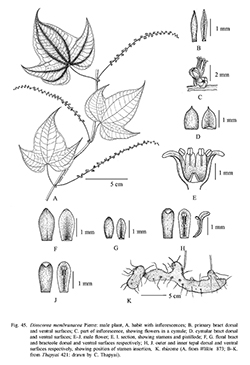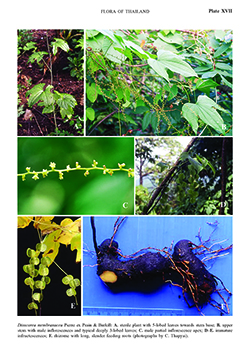e-Flora of Thailand
Volume 10 > Part 1 > Year 2009 > Page 83 > Dioscoreaceae > Dioscorea
25. Dioscorea membranacea Pierre ex Prain & Burkillwfo-0000392394
[Pierre ex Craib in Kew Bull. 407. 1912. nom. nud.], J. & Proc. Asiat. Soc. Bengal 10: 13. 1914; R.Knuth in Pflanzenr. 4, 43: 315. 1924; Prain & Burkill, Bull. Misc. Inform. Kew 1927: 229. 1927; in Fl. Indo-Chine 6: 709. 1934; Ann. Roy. Bot. Gard. (Calcutta) 14(1): 59. 1936; Burkill in Fl. Mal. 4, 3: 305. 1951; Hô, Câyco Viêtnam 3, 2: 934. 1993; Wilkin, Thapyai & Chayamarit, Kew Bull. 62: 255. 2007. Fig. 45, 46; Plate XVII.
Accepted Name : This is currently accepted.
Description : Climber to 10 m. Rhizome ca 4–8 by 1–5 cm, branching and spreading, shallowly buried, periderm hard but lacking rigid, spine-like roots. Indumentum absent. Stems 2–5 mm in diam., twining to the left, annual, unarmed, terete. Leaves simple, alternate, blades ovate to broadly so, membranous to thinly chartaceous and usually translucent when dried, 7–9(–11)-veined, base shallowly to deeply cordate apex acuminate, margins usually deeply 3-lobed, sometimes shallowly so or entire (reproductive shoots only) or with additional lobes (towards stem base); petioles 2–13 cm long; cataphylls and bulbils absent; lateral nodal spines usually present on either side of each node, sometimes absent (especially on distal shoots) or broken off in specimen preparation, curved, hard and rather brittle, to 4 mm long. Inflorescences spicate, pendent, axes sometimes finely tuberculate, tepals inserted on a cup-shaped torus, erect, apices not recurved, fused for ½ to ⅔ of their length. Male inflorescences simple or compound, compound inflorescences 1(–2) per axil, simple/partial inflorescences 1–2(–3) per axil, peduncles 2.2–25 mm long, axes 4–33.5 cm long, with an apparently sessile cymule of (1–)2–3 flowers at each node; female inflorescences 1(–2) per axil, simple. Male flowers 0.8–1.4 mm in diam. at anthesis, outer tepals 1.9–2.3 by 0.6–1, narrowly obovate to obovate-oblong, inner tepals 1.9–2.2 by 0.6–0.8 mm, obovate to obovate-oblong, stamens 6. Female flowers as in Fig. 46B–G. Capsules as in Fig. 46H, J, Pl. 17D, E, 18–21 by 25–40 mm. Seeds 3–6 by 5–7 mm, ovoid-lenticular; wings 17–18 by 15–17 mm, exter ling all around seed margin.
Thailand : NORTHERN: Mae Hong Son, Chiang Mai (Doi Muang Awn, Doi Saket, Doi Suthep-Pui, Mae Hia), Lampang (Chae Son, Ngao), Uttaradit (Queen Sirikit Dam), Tak (Lan Sang, Bhumiphol Dam, Umphang), Nakhon Sawan (Hua Wai); NORTH-EASTERN: Loei (Muang, Wang Saphung); EASTERN: Nakhon Ratchasima (Pak Chong), Chaiyaphum (Phu Khiao); SOUTH WESTERN: Kanchanaburi (Nam Tok Erawan, Sri Sawat); CENTRAL: Chai Nat (Khao Tamamun), Saraburi (Ban Hin Lap, Ban Nong Bua, Muak Lek, Na Pra Larn, Thap Kwang); SOUTH-EASTERN: Chon Buri (Khao Kamphaeng, Khao Khiao, Phattaya, Sri Racha), Chanthaburi (Pong Nam Ron); PENINSULAR: Surat Thani (Lang Tao, Ko Pa-ngan), Nakhon Si Thammarat (Khao Namhom Khiao) Trang (Palien).
Distribution : Vietnam (lectotype), Laos, Burma.
Ecology : Open areas in mixed deciduous forests to lower montane evergreen forests, often on limestone, 50–800 m alt. Flowering: April–July; fruiting: July–November.
Vernacular : Man i yang (มันอียาง)(Saraburi).
Conservation Status: IUCN red list category LC (IUCN 2001).



